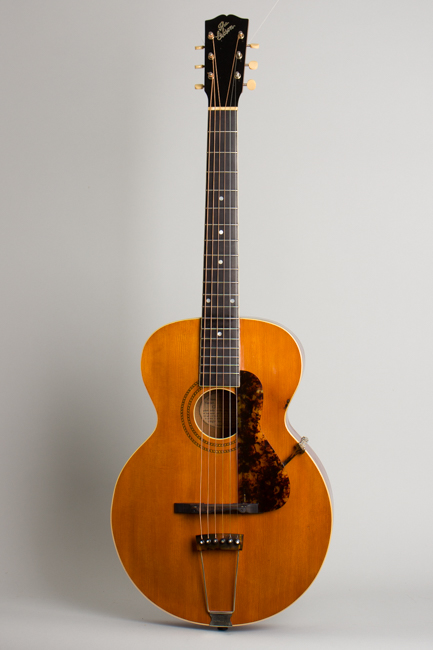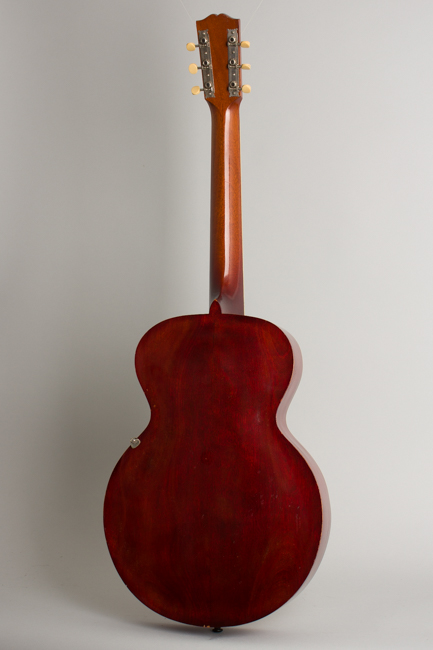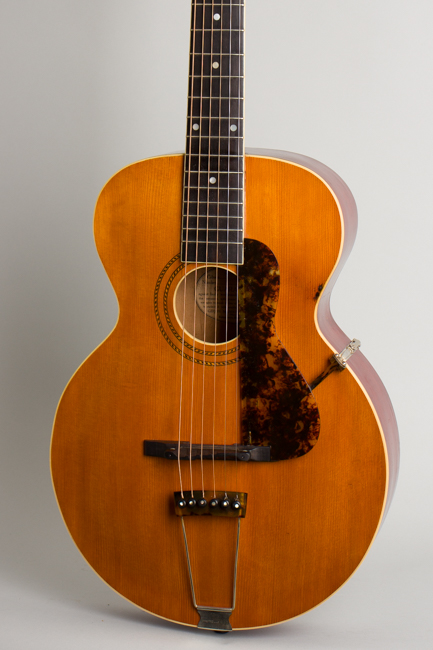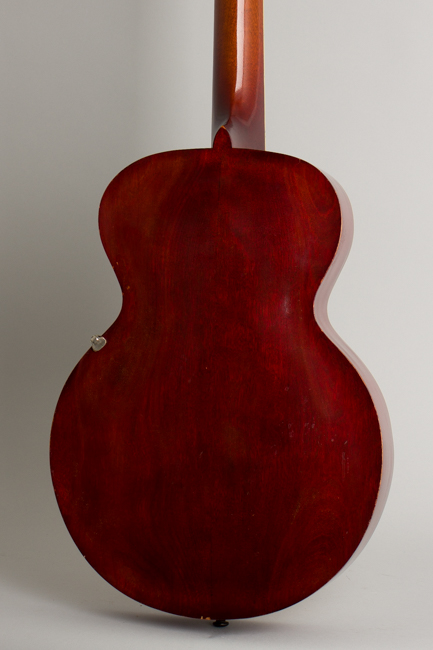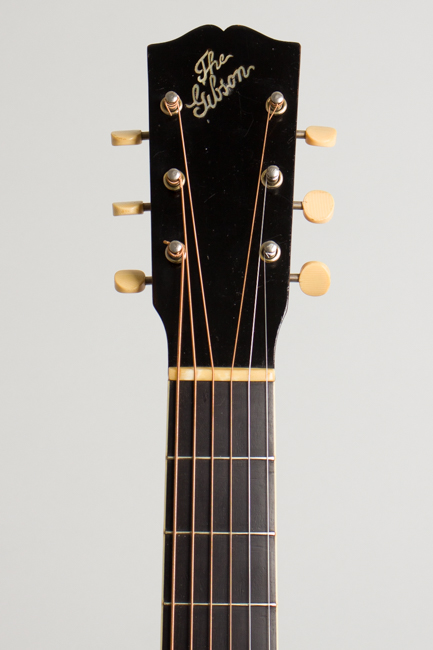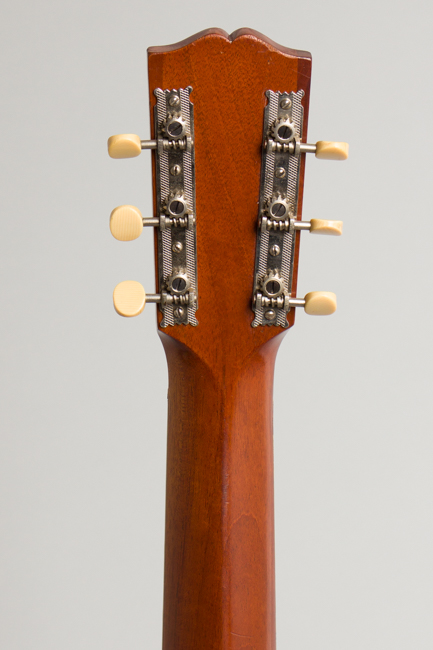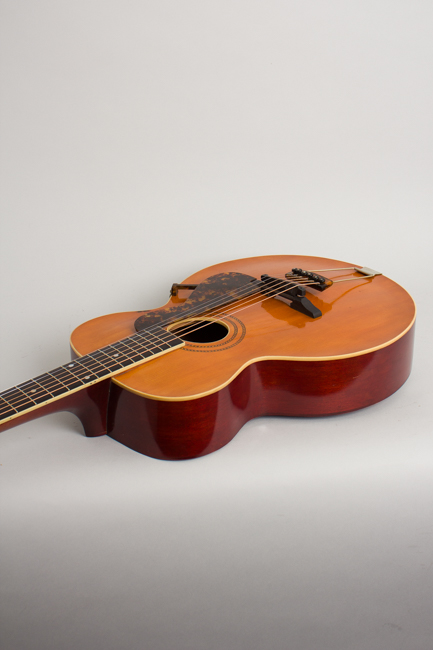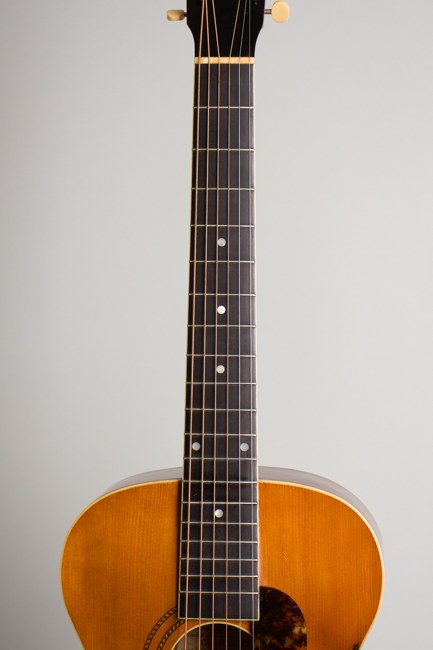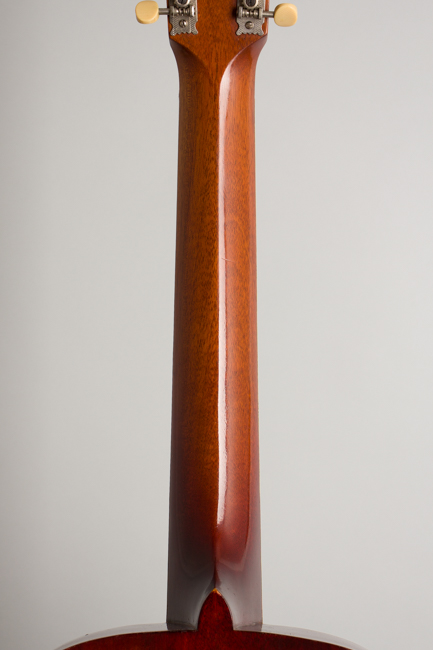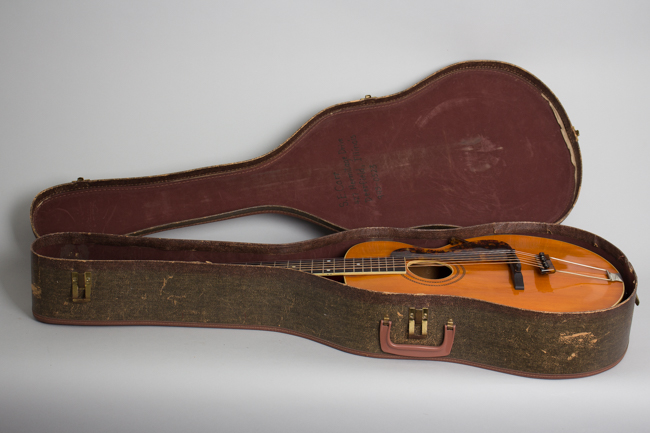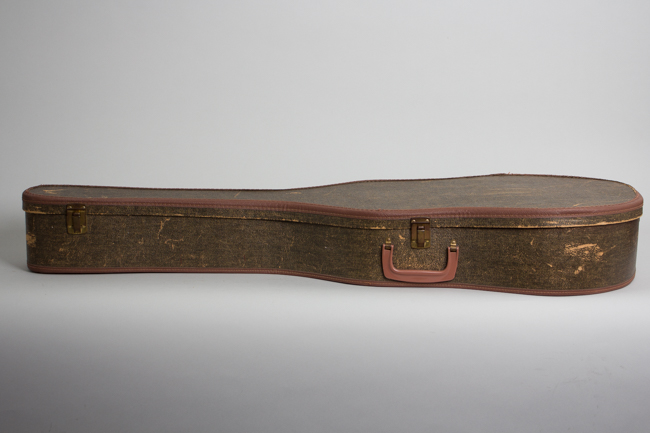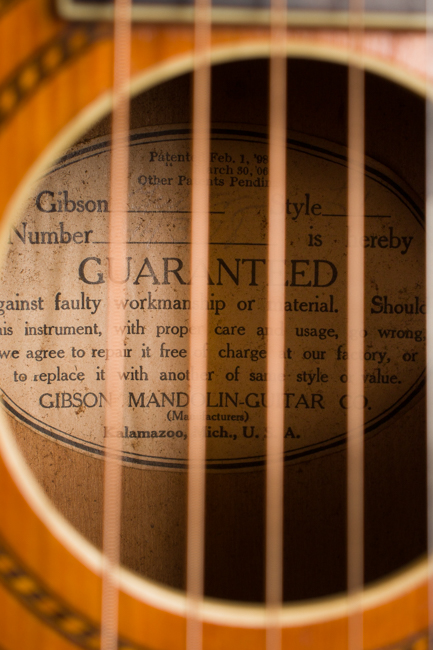Gibson L-1 Arch Top Acoustic Guitar (1918)
Gibson L-1 Model Arch Top Acoustic Guitar (1918), made in Kalamazoo, Michigan, serial # 44371, natural top, cherry stained back and sides finish, birch back and sides, spruce top; mahogany neck with ebony fingerboard, brown chipboard case.
The small-body L-1 was the lowest priced guitar in Gibson's early 1910s line, but still had the company's trademark fully carved top and back. Intended originally primarily as accompaniment for Mandolin orchestras, the early L-1 eventually saw use with early "Hillbilly" bands, vaudeville acts, and even a few primal jazz players before being re-designed as a flat-top instrument in 1926.
This guitar was made in late 1917 and shipped in early 1918. At the time the Gibson company was just 15 years old; they had achieved dominance in the mandolin market but guitars definitely took a back seat until later in the 1920s. The L-1 is built on a 13 3/4" wide birch body with a carved back and carved spruce top; the chunky mahogany neck has a deep soft V profile and is topped with a bound, dot inlaid ebony fingerboard. The classic Gibson "open book headstock is topped with a pearl "The Gibson" script logo and carries the same Handel-made strip tuners as all period Gibsons. A carved ebony bridge, floating celluloid pickguard and oddball period Gibson Pin-trapeze tailpiece complete the hardware.
At the time this L-1 was made most "good" guitars were still gut strung, steel strings being regarded as cheap and vulgar on a guitar! Martin was only just beginning to experiment with steel string Hawaiian guitars in 1916. The early Gibson archtops were totally unique in their day, louder and punchier than most contemporaries if somewhat lacking in sweetness. This small-body model definitely leans in that direction, but has more breadth to the sound than some we have had. Overall this is a fine playing and sounding example, a nice ragtime and early jazz guitar and slightly funky-but-chic cool early Gibson.
Overall length is 38 1/8 in. (96.8 cm.), 13 3/4 in. (34.9 cm.) wide at lower bout, and 3 5/16 in. (8.4 cm.) in depth, measured at side of rim. Scale length is 24 1/2 in. (622 mm.). Width of nut is 1 13/16 in. (46 mm.).
This 105 year old guitar has seen some fairly minor wear over the years but is nearly all original and quite playable. The original non-adjustable carved bridge has been replaced with a nice repro of a 1920s Loar-era Gibson adjustable ebony bridge, more functional if not absolutely correct for the period. The fragile celluloid tailpiece block is intact with the original pins, as is the oft-missing elevated pickguard which has lost the forward bracket; the rear one is still intact.
The fairly thin finish remains original with light overall wear showing some small dings, dents and scrapes but really for a century on is pretty well preserved. The back has a few deeper scratches; the back of the neck is quite clean with minimal play wear and just a few small dinks.
There are no notable repairs except the back/side seams have been resealed long ago in a couple of spots. The top shows some slight puckering around the bridge feet but is fully solid, as is all internal bracing. There are no visible cracks. The original narrow frets are still in good condition with very light wear in the lower positions. This is a cool old small-body carved guitar with a better sound than many; a genuine playable relic of Gibson's early days. Overall Excellent - Condition.
The small-body L-1 was the lowest priced guitar in Gibson's early 1910s line, but still had the company's trademark fully carved top and back. Intended originally primarily as accompaniment for Mandolin orchestras, the early L-1 eventually saw use with early "Hillbilly" bands, vaudeville acts, and even a few primal jazz players before being re-designed as a flat-top instrument in 1926.
This guitar was made in late 1917 and shipped in early 1918. At the time the Gibson company was just 15 years old; they had achieved dominance in the mandolin market but guitars definitely took a back seat until later in the 1920s. The L-1 is built on a 13 3/4" wide birch body with a carved back and carved spruce top; the chunky mahogany neck has a deep soft V profile and is topped with a bound, dot inlaid ebony fingerboard. The classic Gibson "open book headstock is topped with a pearl "The Gibson" script logo and carries the same Handel-made strip tuners as all period Gibsons. A carved ebony bridge, floating celluloid pickguard and oddball period Gibson Pin-trapeze tailpiece complete the hardware.
At the time this L-1 was made most "good" guitars were still gut strung, steel strings being regarded as cheap and vulgar on a guitar! Martin was only just beginning to experiment with steel string Hawaiian guitars in 1916. The early Gibson archtops were totally unique in their day, louder and punchier than most contemporaries if somewhat lacking in sweetness. This small-body model definitely leans in that direction, but has more breadth to the sound than some we have had. Overall this is a fine playing and sounding example, a nice ragtime and early jazz guitar and slightly funky-but-chic cool early Gibson.
Overall length is 38 1/8 in. (96.8 cm.), 13 3/4 in. (34.9 cm.) wide at lower bout, and 3 5/16 in. (8.4 cm.) in depth, measured at side of rim. Scale length is 24 1/2 in. (622 mm.). Width of nut is 1 13/16 in. (46 mm.).
This 105 year old guitar has seen some fairly minor wear over the years but is nearly all original and quite playable. The original non-adjustable carved bridge has been replaced with a nice repro of a 1920s Loar-era Gibson adjustable ebony bridge, more functional if not absolutely correct for the period. The fragile celluloid tailpiece block is intact with the original pins, as is the oft-missing elevated pickguard which has lost the forward bracket; the rear one is still intact.
The fairly thin finish remains original with light overall wear showing some small dings, dents and scrapes but really for a century on is pretty well preserved. The back has a few deeper scratches; the back of the neck is quite clean with minimal play wear and just a few small dinks.
There are no notable repairs except the back/side seams have been resealed long ago in a couple of spots. The top shows some slight puckering around the bridge feet but is fully solid, as is all internal bracing. There are no visible cracks. The original narrow frets are still in good condition with very light wear in the lower positions. This is a cool old small-body carved guitar with a better sound than many; a genuine playable relic of Gibson's early days. Overall Excellent - Condition.
